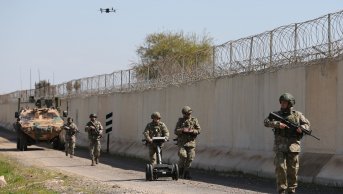The Current and Future State of Terrorism in the Light of the Global Terrorism Index

With a launch event in December, the Global Terrorism Index (GTI) 2020 was presented to a wide audience by the Institute of Economy and Peace. The Index has been one of the most important empirical studies that, for years, has contributed to the efforts, studies and analysis focusing on re-evaluating new developments in the field and reviewing existing anti-terrorism strategies. This review article will highlight the most crucial findings in the Global Terrorism Index, prepared by using the data provided by the University of Maryland Global Terrorism Data Set initiative (START), and it will discuss these findings and make some predictions about them.
According to the Index published for the eighth time this year, while terrorism is in decline at a global scale overall, far-right terrorism has been going through a process of extraordinary increase. This very situation underlines the debate in terrorism studies, that is, that the focus in the literature might need to shift in a way that more seriously addresses the far-right movements. Besides, the center of gravity of the militant Salafist movement, which is considered to be in connection with ISIS but not limited to it, is seen to have shifted from the Middle East to South Asia and Sub-Saharan Africa. In the light of this data, it is possible to foresee the new modus operandi and geographical focus of the group, and, therefore, predict the conflict zones that will come to the fore in the short-term. On the other hand, it would be unrealistic to assume that the declining weight of the Middle East is sustainable unless the dynamics that are present in the region causing the emergence and growth of terrorism are eliminated.
The overall idea that the fight against terrorism will need to both deepen and enlarge in the global sense can also be attributed to the lack of comprehensive and unbiased international initiatives and approaches due to particular ideological and/or pragmatic concerns.
GTI Data and Current Situation in Global Terrorism
According to the Global Terrorism Index, deaths caused by terrorism have decreased by 15% worldwide in the last five years. While 13,800 people have lost their lives due to terrorism worldwide as of the end of 2019, Afghanistan is the country with the highest number of losses. Afghanistan, where 49% of losses (corresponding to 5725 people) occurred, is followed by Nigeria with 9% (1245), Burkina Faso, Mali, Somalia, Iraq, Congo, Yemen, Syria and Mozambique with 2%. While 80% of the losses caused by terrorism took place in these ten countries, the remaining 20% was scattered to other countries across the world.
Looking at the decline in terrorism-related deaths, Afghanistan ranked first with a decrease of 1,654 people compared to the previous year, Nigeria ranked second with 798 people and Iraq third with 480 people. As for the increase in terrorism-related deaths, Burkina Faso takes the first place with 507 people, then comes Sri Lanka with 265 people, and Mozambique with 186 people.
The Index shows that the countries most affected by terrorism are Afghanistan, Iraq, Nigeria, Syria, Somalia, Yemen, Pakistan, India, Congo and the Philippines. It also sheds light to the fact that the most deaths were carried out by the Taliban, Boko Haram, ISIS and al-Shabaab.
In this general picture, it can be seen that Afghanistan experienced fewer terrorism-related losses compared to previous years, but still ranks first in the list. It would be valid to claim that the failure of the peace talks with the Taliban to ensure stability or security and the problems originating from the weak and failed state mechanism are factors that trigger conflict dynamics. In this regard, the density and shape of international engagement in the country are not likely to change in the foreseeable future.
In Sub-Saharan Africa, where the most significant increase in the list can be observed. While the activities of ISIS and al-Qaeda activity continue to intensify, the high number of foreign terrorist fighters (FTFs) in the north of the continent constitutes a significant problem, too. ISIS keeps stretching its geographical focus from the Middle East region, where it emerged from and experienced the peak of its strength and military advances, to the other areas such as Sub-Saharan Africa. This mobility of ISIS makes Sub-Saharan Africa increasingly more critical for the future of terrorism and thus, counter-terrorism efforts. Meanwhile, al-Qaeda continues to spread its network, which it managed to expand and deepen with Boko Haram, to the continent. Due to the expected economic growth rates in Africa, the increasing international interest in the region and the competitive climate, these dynamics in northern and sub-Saharan Africa may turn the continent into one of the key international focal points in the coming years. Being a continent where tension has increased over decades with regards to various issues such as forced migration, civil wars, global and regional struggles of international actors and the involvement of new actors, Africa is a candidate to become the most significant geography of the next decade in the context of global terrorism.
Since their emergence, ISIS and ISIS-affiliated organizations have carried out 3,000 attacks in 48 countries worldwide, causing more than 40,000 deaths. ISIS has recently been recorded to have conducted 382 attacks in 27 countries as of 2019. At this point, South Asia and Sub-Saharan Africa have become regions that provide a suitable environment for ISIS, and Sub-Saharan Africa has, over time, turned into a zone where ISIS is more active. While almost all deaths caused by ISIS in 2014 occurred in the Middle East, this situation changed considerably as of 2019. The loss of lives ISIS caused in the region decreased by 70% between 2014-2019. In other words, only 30% of the deaths caused by ISIS took place in the Middle East. When the deaths caused by ISIS in one year between 2018-2019 are analyzed, the distribution is as follows: 30% in the Middle East, 25% in South Asia, 35% in Sub-Saharan Africa and 10% in other regions. These data reveal the shift in ISIS's range of motion.
In terms of the economic cost of terrorism, the Index shows, terrorism caused approximately 26.4 billion dollars of material damage to the world economy in 2019. This amount is 25% less than the previous year and serves as a proof for the decrease in the last five years. Compared to 2014, when it peaked at 116 billion dollars, the economic impact of terrorism decreased by 77% in 2019. When the data regarding previous years are examined, the most crucial development explaining the steady decline after 2014-2015 proves to be the decrease in ISIS's dominance in the field. Terrorist activity shows its economic impact in Sub-Saharan Africa as well. In terms of the financial costs on a regional basis, we can enumerate the first three regions as Sub-Saharan Africa (12.5 billion dollars), South Asia (5.6 billion dollars), and Middle East-North Africa (4.7 billion dollars), respectively. As for the ratio of economic cost to a country's gross national product (GNP), the top three countries are as follows: Afghanistan (16.7%), Syria (3.4%) and Nigeria (2.4%). It should not be forgotten that the economic burden of terrorism constitutes significant obstacles for the areas where terrorist organizations may get a foothold, especially in countries with already weak state mechanisms and subsequent resource management and distribution problems.
The Rise of Far-Right Terrorism
According to the Global Terrorism Index, far-right terrorism, covering a wide range of (and in many cases intertwining) key ideas from white supremacism to Islamophobia and from xenophobia to Turcophobia has increased by 250% in North America, Western Europe and Australia in the last five years; the killing of 77 people in Norway by Anders Breivik and 51 people by Brenton Tarrant in New Zealand had a remarkable impact on global public opinion. This development led to the emergence of the debate on whether the far-right will become the new gravity center of global terrorism. The second most significant development in the field, following the decline of ISIS in the Middle East and its orientation towards Sub-Saharan Africa, is, thus, this rapid increase in far-right terrorism in the Western world. In this respect, 2019 was a year in which far-right terrorists carried out quite shocking attacks worldwide. First, in March, two mosques in Christchurch, New Zealand, were attacked by Brenton Tarrant during Friday prayer, as a result of which 51 people lost their lives and 49 were injured. In August, 23 people were killed and another 23 wounded in an attack by Patrick Crusius in a shopping mall in El Paso, Texas. Out of 108 terror-related deaths in the West in 2019, 89 were committed by far-right terrorists. On the economic front, the economic cost of terrorism for New Zealand, the US and Germany, which were most affected by far-right terrorism, was 532, 297 and 59.5 million dollars, respectively. Despite the increasing awareness in terms of the fight against far-right terrorism in the West, considering the GNP of the countries taken into account, we can see that the budgets allocated to the fight against terrorism are still relatively small. This suggests that, if enough funding is not assigned to fight against terrorism today for specific actions such as surveillance, counteracting, infiltration, or any other means regarded timely and necessary, it may be too late to do it tomorrow and not yield the desired effect. Unlike the extreme left terrorist activity during the Cold War, far-right terrorism has not been encouraged or nourished from a non-Western source at its period of emergence. Furthermore, it did not originate from a conflict zone, contrary to the widely held terrorism perception of the post-9/11 era. Instead, it originates from and strengthens itself in Europe with higher GDP and much longer experience of democracy compared to many other regions and countries. When the terrorist attacks and deaths caused by terrorism in the West in 2019 are examined, it is revealed that the far-right terrorists carried out 46% of the attacks and caused 82% of the deaths, and at least 35 far-right terrorist attacks have occurred every year in the last five years. Far-right terrorism has also been a key component of the terrorism scene in the US, too. One hundred and sixty-seven of the 332 attacks that took place between 2002 and 2019 were in the USA. The US is followed by Germany with 48 attacks and the UK with 35 attacks. Given the death toll, the US is clearly ahead of the other countries. While the deaths caused by far-right terrorism in the same period were 286 in total, 113 of these were in the USA. In this period, far-right terrorists believing in white supremacy also caused 78 deaths in Norway and 51 deaths in New Zealand. Whether this leap forward in far-right terrorist activities in the US is related to the Trump administration and its attitude that is considered to be far-right-tolerant and even supportive or it rather represents a long-term trend will be one of the most important research topics in the Biden era.
Conclusion
Considering the key findings of GTI, terrorism and terrorism-related deaths seem to be in decline. Along with this general picture, however, two key points might prove the opposite in the short to medium-term.
Firstly, ISIS has been increasingly shifting its focus from the Middle East towards sub-Saharan Africa and, at a lower rate (but still significant), to South Asia. This situation increases the importance of Sub-Saharan Africa in particular and the need for urgent peaceful solutions to existing conflicts in the region which can further provide fertile ground for the group. The current African equation as the whole continent, on the other hand, is highly problematic because of the conflicting interests between the new actors arrived in the region and the old actors, and of the decades-old security problems in the continent that are quite demanding to eliminate in the foreseeable future. On the contrary, with the weaknesses in state mechanisms taken into account, it is highly probable for the conflicts to deepen and spread around. Furthermore, the local and regional dynamics that paved the way for the strengthening of ISIS in the Middle East, the al-Qaeda getting a foothold and the emergence of similar organizations with parallel mindsets still prevail. Plus, no concrete solution roadmap is on the horizon with respect to the camps where FTFs or people allegedly linked to ISIS and their relatives are located, to the inadequacy and unwillingness of the countries in terms of repatriation and trial processes. Due to all these reasons, the possibility for the current atmosphere to undergo a concrete, substantial and sustainable improvement that would prevent any similar group from strengthening seems quite low if not non-existent. The Middle East, thus, is and will be one of the focus areas of terrorism studies.
Secondly, contrary to the last two decades, West-centered and far-right terrorism are on the rise. The "lone actor" terrorists, fed by far-right ideology, generally radicalized in cyberspace, carried out attacks and over years turned into one of the most significant terrorist threats in the West. Along with offline contacts revealed during trial processes, online transboundary communication and networks from money transfers to sharing ideas and expertise online, attack planning and fundraising activities also point out a quite concerning trend in transnationalization of contemporary far-right terrorism. Not limiting themselves to their own countries, far-right terrorists can also form illegal or legal branches (depending on the core’s preference with respect to the symbolism, use of violence, political participation etc.) across Europe. Beyond the violent dimension of far-right activity and mobilization, the number of countries in Europe where the far-right discourse has become the mainstream political discourse or partly contributes to it also stands out as another wake up call. This dataset also suggests that the current threat is much deeper than observed, and the increasing number of attacks may be evaluated as early signals, not even close to being considered as the peak of this threat. Considering this rise in far-right activity and the returning YPG-affiliated FTFs getting more attention in extreme-left groups in their home countries due to their field experience, the consequences of adopting soft-handed policies vis-à-vis terrorist organizations based on ideological preferences or pragmatic needs will be with us for some time. Several unfamiliar focal points of terrorism seem to emerge in the short-term. Along with the new areas where ISIS, al-Qaeda and like-minded groups deepen their presence, they are in the old areas where they are already influential but have a lower profile.









